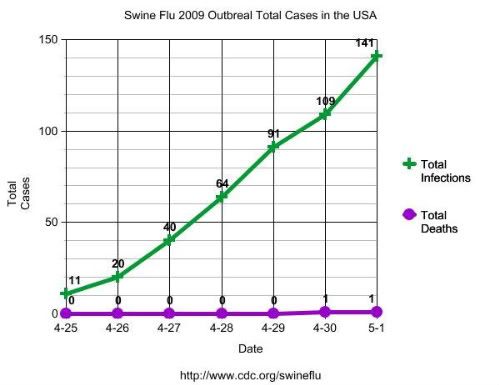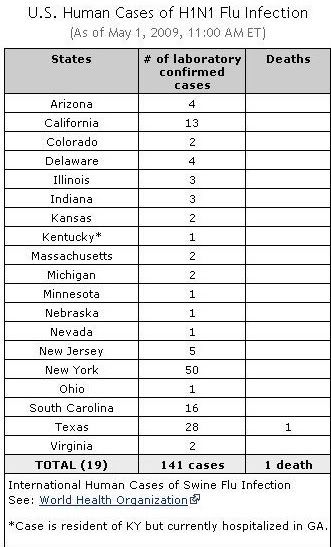

- Sick people (students, faculty and staff) should stay home unless they need to seek medical care and stay away from schools regardless of whether schools and childcare facilities are operating normally or have dismissed students or closed, respectively.
- Dismissal of students in a school and closure of childcare facilities should be considered in schools with one or more laboratory-confirmed or non-subtypable influenza A case among students, faculty or staff in order to decrease the spread of illness in the community.
- Dismissal of students from schools and closure of childcare facilities should be considered for not-yet-affected schools and childcare facilities in the same area (e.g. a feeder school network or a geographic area) if more than one school or childcare facility in that area has confirmed or non-subtypable influenza A cases among their students, faculty, or staff. This would include preemptively dismissing students from schools in that area, including schools without current laboratory-confirmed cases.
- Neighboring schools to those that dismiss students should also consider preemptively dismissing students from schools without current laboratory-confirmed cases. Issues to consider include geographic proximity and extent of mixing of student populations among area schools.
- If a school dismisses students or a childcare facility closes, school or childcare-related gatherings should also be canceled. Parents and students should be encouraged to avoid congregating in large numbers outside of the school setting.
If a school dismisses students or a childcare facility closes, schools and childcare facilities should close for up to 14 days depending on the extent and severity of the illness and in close consultation with local and state public health officials (additional guidance on duration of school closures will be provided no later than May 8). This length of time is recommended because children are likely to be infectious for about 7 – 10 days after the onset of illness. Schools, in consultation with local and state public health officials, should evaluate daily the need for possible extension of the dismissal/closure based on local influenza surveillance information and the occurrence of new infections and severity of illness in the community from this virus.
Prevention in humans
- Prevention of pig to human transmission
The transmission from swine to human is believed to occur mainly in swine farms where farmers are in close contact with live pigs. Although strains of swine influenza are usually not able to infect humans this may occasionally happen, so farmers and veterinarians are encouraged to use a face mask when dealing with infected animals. The use of vaccines on swine to prevent their infection is a major method of limiting swine to human transmission. Risk factors that may contribute to swine-to-human transmission include smoking and not wearing gloves when working with sick animals.[43]
- Prevention of human to human transmission
Influenza spreads between humans through coughing or sneezing and people touching something with the virus on it and then touching their own nose or mouth.[44] Swine flu cannot be spread by pork products, since the virus is not transmitted through food.[44] The swine flu in humans is most contagious during the first five days of the illness although some people, most commonly children, can remain contagious for up to ten days. Diagnosis can be made by sending a specimen, collected during the first five days for analysis.[45]
Recommendations to prevent spread of the virus among humans include using standardinfection control against influenza. This includes frequent washing of hands with soap and water or with alcohol-based hand sanitizers, especially after being out in public.[46] Although the current trivalent influenza vaccine is unlikely to provide protection against the new 2009 H1N1 strain,[47] vaccines against the new strain are being developed and could be ready as early as June 2009.[48]
Experts agree that hand-washing can help prevent viral infections, including ordinary influenza and the swine flu virus. Influenza can spread in coughs or sneezes, but an increasing body of evidence shows small droplets containing the virus can linger on tabletops, telephones and other surfaces and be transferred via the fingers to the mouth, nose or eyes. Alcohol-based gel or foam hand sanitizers work well to destroy viruses and bacteria. Anyone with flu-like symptoms such as a sudden fever, cough or muscle aches should stay away from work or public transportation and should contact a doctor to be tested.
Social distancing is another tactic. It means staying away from other people who might be infected and can include avoiding large gatherings, spreading out a little at work, or perhaps staying home and lying low if an infection is spreading in a community. Public health and other responsible authorities have action plans which social distancing actions to request or require depending on the severity of the outbreak.
Swine flu panic is spreading in Mexico and soldiers are patrolling the streets after it was confirmed that human to human transmission is occurring and that the virus is a brand new strain which is seemingly affecting young, healthy people the worst. Questions about the source of the outbreak are also being asked after a public health official said that the virus was “cultured in a laboratory”.
“This strain of swine influenza that’s been cultured in a laboratoryis something that’s not been seen anywhere actually in the United States and the world, so this is actually a new strain of influenza that’s been identified,” said Dr. John Carlo, Dallas Co. Medical Director (video clip here).
Was this a slip-up or an admission that this new super-strain of swine influenza was deliberatelycultured in a laboratory and released?
According to two mainstream media journalists, one in Mexico City and the other in Jakarta, who spoke to WMR on background, they are convinced that the current outbreak of a new strain of swine flu in Mexico and some parts of the United States is the result of the introduction of a human-engineered pathogen that could result in a widespread global pandemic, with potentially catastrophic consequences for domestic and international travel and commerce.
Alex Jones stated in this appearance:






























2 comments :
http://bondibeachs.blogspot.com
your blog site is very nice plz check my blog site.give me more comments.
Post a Comment